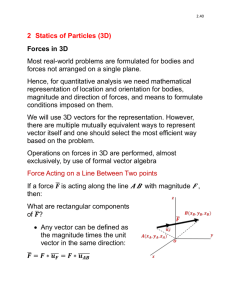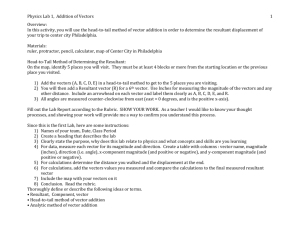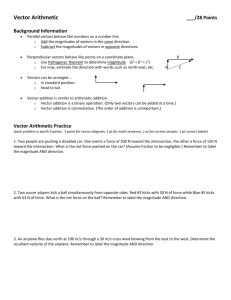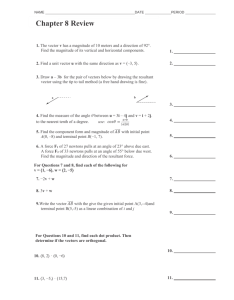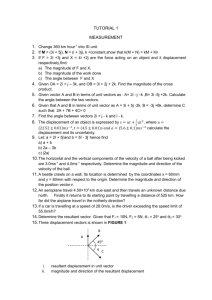Word
advertisement
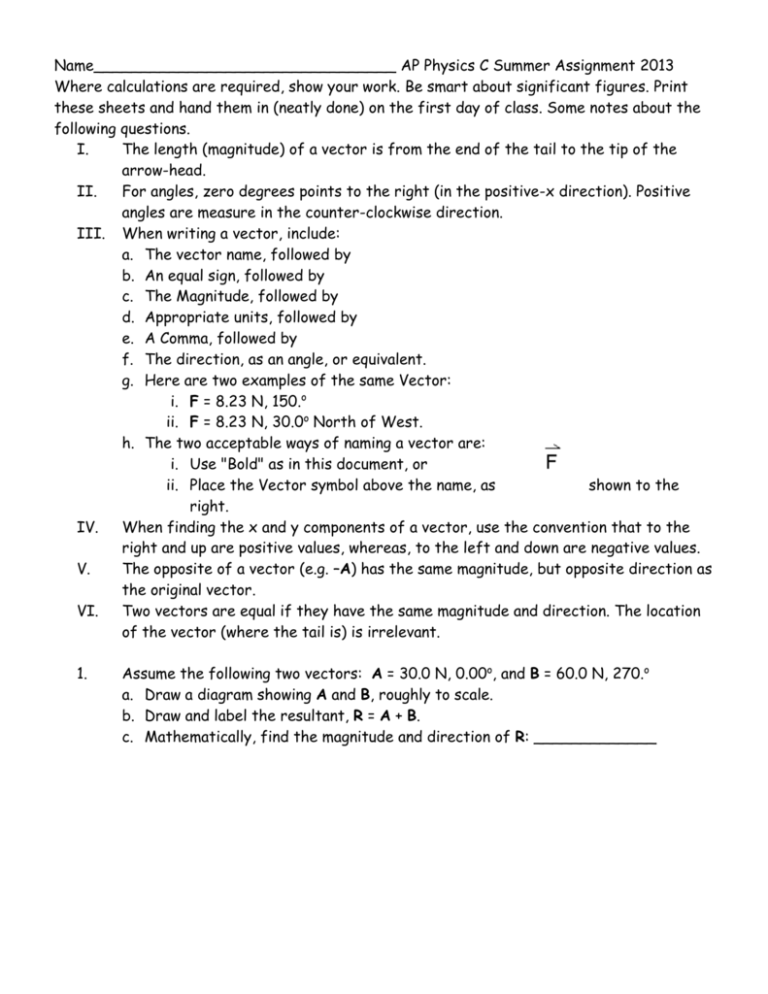
Name________________________________ AP Physics C Summer Assignment 2013 Where calculations are required, show your work. Be smart about significant figures. Print these sheets and hand them in (neatly done) on the first day of class. Some notes about the following questions. I. The length (magnitude) of a vector is from the end of the tail to the tip of the arrow-head. II. For angles, zero degrees points to the right (in the positive-x direction). Positive angles are measure in the counter-clockwise direction. III. When writing a vector, include: a. The vector name, followed by b. An equal sign, followed by c. The Magnitude, followed by d. Appropriate units, followed by e. A Comma, followed by f. The direction, as an angle, or equivalent. g. Here are two examples of the same Vector: i. F = 8.23 N, 150.o ii. F = 8.23 N, 30.0o North of West. h. The two acceptable ways of naming a vector are: i. Use "Bold" as in this document, or ii. Place the Vector symbol above the name, as shown to the right. IV. When finding the x and y components of a vector, use the convention that to the right and up are positive values, whereas, to the left and down are negative values. V. The opposite of a vector (e.g. –A) has the same magnitude, but opposite direction as the original vector. VI. Two vectors are equal if they have the same magnitude and direction. The location of the vector (where the tail is) is irrelevant. 1. Assume the following two vectors: A = 30.0 N, 0.00o, and B = 60.0 N, 270.o a. Draw a diagram showing A and B, roughly to scale. b. Draw and label the resultant, R = A + B. c. Mathematically, find the magnitude and direction of R: _____________ 2. The diagram above shows two vectors. Assume that they are drawn to scale. The scale is: 1.0 cm = 2.0 N. Using a ruler and protractor….. a. State the vector A ________________________ b. State the vector B ________________________ c. Draw and label the x and y components of both A and B. d. Using the same scale, fill in the following table: Vector A B x-component (N) y-component (N) 3. The above is the same vector diagram as in question #1. a. Using the parallelogram method, draw the Resultant of A and B, R. b. Using a ruler and protractor, measure the magnitude and direction of R. State the vector R: __________________________ 4. Assume the following two Forces: A = 40.0 N, 37.0o B = 100.0 N, 225o. a. Mathematically find the two components of A and B, and put the values in the following table: Vector x-component (N) y-component (N) A B R b. Mathematically, find the x and y-components of the Resultant and write the results in the table. c. Mathematically, find the Resultant vector, R: ___________________ 5. Using a scale of 1.0 cm = 2.0 N, on the axes below: a. Draw the force vector: A = 8.0N, 120o. b. Draw the force vector B = -A. c. State the value of vector, B ______________________ 6. There are 5 Vectors drawn in the diagram to the right. Assume that the size of all divisions (x and y) are the same. Label True or False for each of the following assertions: a. A = B _____ b. C = D _____ c. D = E _____ d. C = -D _____ e. C + E = 0 _____ f. The magnitude of C is equal to the magnitude of E _____ g. The magnitude of A is equal to the magnitude of E _____ h. The direction of C is equal to the direction of E _____ For the Multiple Choice questions, circle THE LETTER of the best answer! 7. A boy exerts a force F in pulling a sled by means of a cord making an angle A to the ground. Fh is the horizontal component of F, and Fv is the vertical component of F. If the angle A is increased while the magnitude of F is kept constant:: (A) both Fh and Fv will increase (B) both Fh and Fv will decrease (C) Fh will increase but Fv will decrease (D) Fv will increase but Fh will decrease 8. A man pushes a lawnmower by applying a force of 20.0 N. to the handle which is held at an angle of 30.0 degrees to the ground. The horizontal component of the man's force is approx: (A) 5.00 N (B) 8.67 N (C) 0.00 N (D) 17.4 N 9. A rifle bullet is fired upward at an angle of 60.0 degrees to the ground with an initial velocity of 100.0 ft/sec. The vertical component of the bullet's velocity is: (A) 50.0 ft/s (B) 60.0 ft/s (C) 867 ft/s (D) 100.0 ft/s 10. Which of the following groups of three concurrent forces CANNOT be in equilibrium? (A) 3N 4N 2N (B) 4N 4N 1N (C) 2N 3N 2N (D) 4N 3N 8N 11. A body in equilibrium: (A) must be at rest (B) may be moving with varying speeds in a straight line (C) may be moving at constant speed in a curved path (D) may be moving at constant speed in a straight line 12. Forces of 75.0 N, 90.0 N and 130. N act at a point to produce equilibrium. The resultant of the 90.0 N and the 130. N forces has magnitude: (A) 40 N (B) 75 N (C) 110 N (D) 220 N 13. Which of the following is never a vector quantity? (A) Velocity (B) Force (C) Displacement (D) Acceleration (E) Time 14. If one or more forces act on an object, then the Equilibrant is a force that: (A) Is equal in magnitude to the largest force acting on an object. (B) Has the same direction as the Resultant. (C) Is equal to the Resultant. (D) Is equal and opposite to the Resultant. 15. Sean is in a boat traveling 3.8 m/s straight across a river 240 m wide. The river is flowing at 1.6 m/s. (a) How long does it take Sean to cross the river? (b) How far is Sean downstream when he reaches the other side?

